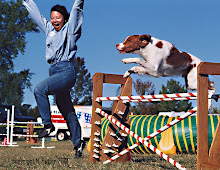[This was originally posted to the Fairmount Animal Hosptial website on 28 September 2008.]
Dear Dr. Lee,
My husband and I just got a young, rescue German Shorthair Pointer. He is so sweet, but we are having a problem with him coming to us when called when he is outside. All he wants to do is sniff. My husband wants to get an electronic collar for him. I think that would be mean. What do you think?
Sincerely,
WannaBNice in Nedrow
Dear WannaBNice,
Electronic collars can be used to train dogs using a process called negative reinforcement. When the collar shocks a dog, it is painful and undesirable, so theoretically, the dog should do all he can to avoid the negative stimulus. The problem with electronic collars is that they require exquisite timing, else the dog may not understand what he is being punished for, and over time, mistimed punishments can create anxiety, fear and confusion. Also, the dog needs to understand just what he is being punished for, so if your dog does not understand a “come” command in the first place, the painful shock certainly will not help the situation.
In general, I recommend training with positive reinforcement (rewarding behaviors you do want your dog to exhibit) and negative punishment (removing something the dog wants to decrease the chance the undesirable behavior will occur again). For example, if I ask my dog to “come” and he does, he gets a yummy treat, and if he does not, the treat goes away (I pocket it, I give it to another, well-behaved dog, or, if I find it edible, I eat it). A “come” command can easily be trained by having the dog on a leash and flat collar. Start with small distances in a relatively distraction-free environment, and gradually increase the distance and distraction level as your dog progresses. The reward can be a small food treat, verbal praise, petting, play with a toy, or a combination of these.
The American Veterinary Society of Animal Behavior has generated a position statement regarding punishment which states that punitive methods and tools (i.e., choke collar, prong collar, electronic collar, or other physical forms of punishment) should never be used initially in training. It also states that if such methods are offered, the handler of the dog should be made fully aware of possible negative consequences that can result. The actual position statement can be found at http://www.avsabonline.org/avsabonline/images/stories/Position_Statements/Combined_Punishment_Statements.pdf .
Sincerely,
Dr. Lee
My primary objective is to help pets and owners enjoy a more satisfying relationship with each other and maintaining the pet’s health to maintain the pet’s quality of life. Pets have the ability to enrich our lives immensely, and I feel that owners also have a responsibility to enrich their pets’ lives, too.
Got a pet behavior question?
E-mail me at fah@fairmountanimal.com.
